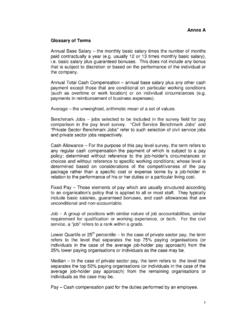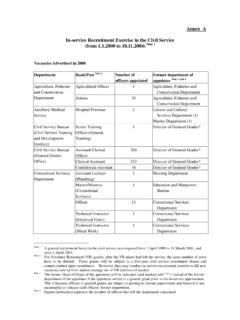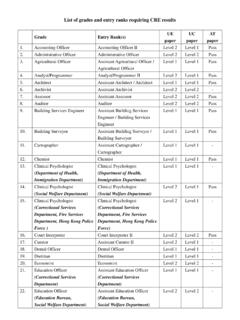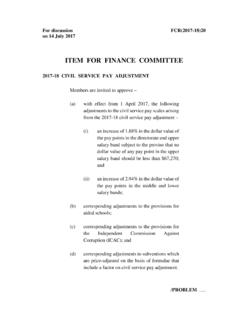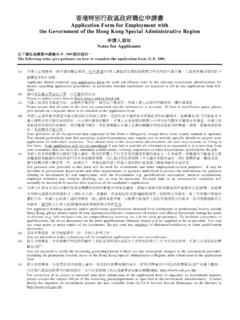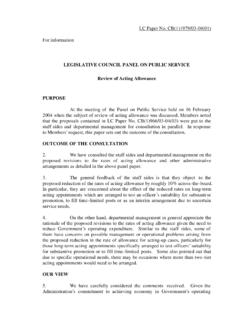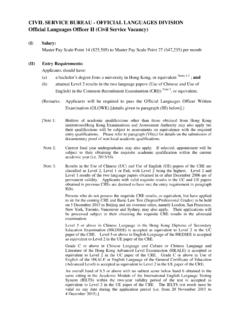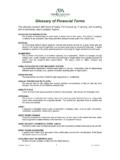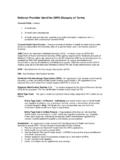Transcription of Annex A Glossary of Terms - csb.gov.hk
1 1 Annex A Glossary of Terms Annual Base Salary the monthly basic salary times the number of months paid contractually a year ( usually 12 or 13 times monthly basic salary), basic salary plus guaranteed bonuses. This does not include any bonus that is subject to discretion or based on the performance of the individual or the company. Annual Total Cash Compensation annual base salary plus any other cash payment except those that are conditional on particular working conditions (such as overtime or work location) or on individual circumstances ( payments in reimbursement of business expenses). Average the unweighted, arithmetic mean of a set of values. Benchmark Jobs jobs selected to be included in the survey field for pay comparison in the pay level survey.
2 Civil Service Benchmark Jobs and Private Sector Benchmark Jobs refer to such selection of civil service jobs and private sector jobs respectively. Cash Allowance For the purpose of this pay level survey, the term refers to any regular cash compensation the payment of which is subject to a pay policy; determined without reference to the job-holder s circumstances or choices and without reference to specific working conditions; whose level is determined based on considerations of the competitiveness of the pay package rather than a specific cost or expense borne by a job-holder in relation to the performance of his or her duties or a particular living cost. Fixed Pay Those elements of pay which are usually structured according to an organisation s policy that is applied to all or most staff.
3 They typically include basic salaries, guaranteed bonuses, and cash allowances that are unconditional and non-accountable. Job A group of positions with similar nature of job accountabilities, similar requirement for qualification or working experience, or both. For the civil service, a job refers to a rank within a grade. Lower Quartile or 25th percentile In the case of private sector pay, the term refers to the level that separates the top 75% paying organisations (or individuals in the case of the average job-holder pay approach) from the 25% lower paying organisations or individuals as the case may be. Median In the case of private sector pay, the term refers to the level that separates the top 50% paying organisations (or individuals in the case of the average job-holder pay approach) from the remaining organisations or individuals as the case may be.
4 Pay Cash compensation paid for the duties performed by an employee. 2 Pay Level Statistics Any group of statistics that indicate the levels and prevalence of pay practices in a pay market, including upper quartile, median, lower quartile, average and weighted average. Pay Policy An organisation s guidelines on how to determine the level of a job-holder s compensation; may include a reference to a position in the pay market ( , median), a target pay level, a range of a minimum to a maximum, a defined level of cash allowances, and eligibility for variable pay. Pay Practice or Organisation Practice The actual manner in which an organisation s pay policy is put into practice, the amount of pay actually given to typical job-holders.
5 Position a post in an organisation occupied by a single incumbent that may have a very specific set of duties which may differ from the duties of other positions. Private Sector Organisations For the purpose of this final report, the term should be interpreted broadly as including any non-government organisation regardless of ownership and nature of business or operations (public or private, local or multinational, profit-making or non-profit making). Total Remuneration The total value of all remuneration components including pay, allowances and employee benefits paid in cash or provided in kind, etc. an individual will receive for being an employee of the organisation. Upper Quartile or 75thPercentile Level In the case of private sector pay, the term refers to the level that separates the top 25% paying organisations (or individuals in the case of the average job-holder pay approach) from the 75% lower paying organisations or individuals as the case may be.
6 Variable Pay Those elements of pay which are determined periodically with regard to individual or organisational performance, including profit sharing bonus, annual incentive payment, performance bonus, merit awards, sales commissions, attendance awards, etc. For the purpose of this report, the term refers to short-term or annual payments based on performance over a period of twelve months or less, whilst long-term incentives (such as stock options) are awards whose value may vary and are based on performance over more than 12 months. Weighted Average The mean of a set of values where the contribution of each value depends on another quantity ( , number of employees in a job). 1 Annex B Summary of the 1986 Pay Level Survey the job factor comparison method and the lessons learnt This Annex discusses the use of the job factor comparison method in the 1986 Pay Level Survey.
7 The objective of the 1986 Pay Level Survey was to examine whether the remuneration of civil servants was broadly in line with those of the private sector counterparts. The consultants were asked to make broad comparisons on pay levels and not to compare the pay levels of individual jobs. Having considered the proposals submitted by a number of consulting firms, the Standing Commission on Civil Service Salaries and Conditions of Service selected the Hay Guide Chart-Profile method of job evaluation proposed by the Hay Management Consultants for the purpose of the survey. The Hay Guide Chart-Profile Method of Job Evaluation This method is used by many organisations around the world in the private and public sectors, including civil services in Australia, Canada, New Zealand, Singapore, United Kingdom, and United States, as well as provincial, state and local governments in those countries.
8 Under this survey method, a representative sample of civil service jobs and a similarly representative sample of jobs in the private sector were selected. Following an analysis of the job content of the selected samples based on certain specified job-related factors ( level of accountability), a pay level comparison was made between civil service jobs and private sector jobs assessed to be comparable. Each job under survey was evaluated by reference to the following three job factors and given a score for each factor Job Factor Definition Component Dimension Know-How The total of every kind of knowledge, skill and experience required for doing a job competently. Technical Know-How Management Know-How Human Relations Know-How Problem Solving The mental application, which employs know-how, to identify, define and resolve problem.
9 Thinking Environment Thinking Challenge AccountabilityThe answerability for action and for the consequences of that action. Freedom To Act Magnitude Job Impact on End Results A series of three Guide Charts have been drawn up for each of these factors. Scores are read from a matrix that combines the levels for the component dimensions of each evaluation factor. For each factor, the higher the level of difficulty involved in the job, the higher was the score given to the 2 job concerned. The scores for individual factors for each job under survey were then added to give a total score. The total point score can be used as the basis for comparison of jobs across organisations. The remuneration packages of civil service jobs were compared with those of private sector jobs receiving the same range of total scores.
10 Comments of Staff Representatives Relating to Job Evaluation The final report of the Commission of Inquiry summarised the staff side comments relating to the job evaluation methodology: The Hay methodology was considered suitable for determining the internal relativities of private sector jobs and senior management in the civil service but not suitable for external relativities comparison. The methodology of the survey was too broadbrush and had a limited statistical basis. The Hay methodology took into account only three factors , know-how, problem-solving and accountability. This ignored other important factors, , skill, experience, physical effort, working conditions, etc. It was therefore unsuitable for evaluating complex civil service jobs, nor did it take into account the special features of the police force or other disciplined services.
